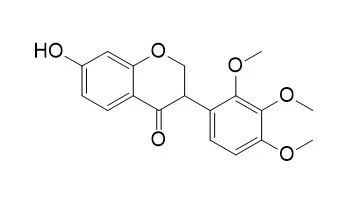| In vitro: |
| Planta Med . 1998 Mar;64(2):153-8. doi: 10.1055/s-2006-957394. | | Three new flavonoids and antiallergic, anti-inflammatory constituents from the heartwood of Dalbergia odorifera[Pubmed: 9525107] | | Three new flavonoids, (3R)-4'-methoxy-2',3,7-trihydroxyisoflavanone (11), 7-methoxy-3,3',4',6-tetrahydroxyflavone (18), and 2',7-dihydroxy-4',5'-dimethoxyisoflavone (22), were isolated from the heartwood of Dalbergia odorifera T. Chen. (Leguminosae), together with twenty-two known compounds, (S)-4-methoxydalbergione (1), cearoin (2), medicarpin (3), formononetin (4), sativanone (5), 3-hydroxy-9-methoxy-coumestan (6), meliotocarpan A (7), isoliquiritigenin (8), stevein (9), liquiritigenin (10), 3',4',7-trihydroxyflavanone (12), butein (13), 3'-hydroxymelanettin (14), koparin (15), bowdichione (16), fisetin (17), melanettin (19), sulfuretin (20), 3'-hydroxydaidzein (21), 3'-O-Methylviolanone (23), xenognosin B (24), and dalbergin (25). These flavonoids were evaluated in antiallergic and anti-inflammatory tests. The results showed that (S)-4-methoxydalbergione (1) and cearoin (2) exhibited antiallergic activity while (S)-4-methoxydalbergione (1), cearoin (2), butein (13), koparin (15), bowdichione (16), 3'-O-Methylviolanone (23), and xenognosin B (24) showed significant anti-inflammatory activity. | | Molecules . 2021 Sep 4;26(17):5381. | | Dihydroisocoumarins and Dihydroisoflavones from the Rhizomes of Dioscorea collettii with Cytotoxic Activity and Structural Revision of 2,2'-Oxybis(1,4-di-tert-butylbenzene)[Pubmed: 34500814] | | The investigation of the constituents of the rhizomes of Dioscorea collettii afforded one new dihydroisocoumarin, named (-)-montroumarin (1a), along with five known compounds-montroumarin (1b), 1,1'-oxybis(2,4-di-tert-butylbenzene) (2), (3R)-3'-O-Methylviolanone (3a), (3S)-3'-O-Methylviolanone (3b), and (RS)-sativanone (4). Their structures were elucidated using extensive spectroscopic methods. To the best of our knowledge, compound 1a is a new enantiomer of compound 1b. The NMR data of compound 2 had been reported but its structure was erroneous. The structure of compound 2 was revised on the basis of a reinterpretation of its NMR data (1D and 2D) and the assignment of the 1H and 13C NMR data was given rightly for the first time. Compounds 3a-4, three dihydroisoflavones, were reported from the Dioscoreaceae family for the first time. The cytotoxic activities of all the compounds were tested against the NCI-H460 cell line. Two dihydroisocoumarins, compounds 1a and 1b, displayed moderate cytotoxic activities, while the other compounds showed no cytotoxicity. | | Antioxidants (Basel) . 2020 Apr 10;9(4):306. | | Polyphenols and Sesquiterpene Lactones from Artichoke Heads: Modulation of Starch Digestion, Gut Bioaccessibility, and Bioavailability following In Vitro Digestion and Large Intestine Fermentation[Pubmed: 32290151] | | Artichoke is a relevant source of health-promoting compounds such as polyphenols and sesquiterpene lactones. In this study, the bioaccessibility and gut bioavailability of artichoke constituents were evaluated by combining in vitro digestion and large intestine fermentation, metabolomics, and Caco-2 human intestinal cells model. Moreover, the ability of artichoke polyphenols to modulate the in vitro starch digestibility was also explored. An untargeted metabolomic approach based on liquid chromatography quadrupole-time-of-flight (UHPLC/QTOF) mass spectrometry coupled with multivariate statistics was used to comprehensively screen the phytochemical composition of raw, digested, and fermented artichoke. Overall, a large abundance of phenolic acids and sesquiterpene lactones was detected, being 13.77 and 11.99 mg·g-1, respectively. After 20 h of in vitro large intestine fermentation, a decrease in polyphenols and sesquiterpene lactones content was observed. The most abundant compounds characterizing the raw material (i.e., chlorogenic acid and cynaropicrin equivalents) showed an average % bioaccessibility of 1.6%. The highest % bioaccessibility values were recorded for flavonoids such as anthocyanin and flavone equivalents (on average, 13.6%). However, the relatively high bioavailability values recorded for flavonols, phenolic acids, and sesquiterpene lactones (from 71.6% up to 82.4%) demonstrated that these compounds are able to be transported through the Caco-2 monolayer. The phenolic compounds having the highest permeation rates through the Caco-2 model included low molecular weight phenolics such as tyrosol and 4-ethylcatechol; the isoflavonoids 3'-O-Methylviolanone, equol 4'-O-glucuronide, and hydroxyisoflavone; together with the methyl and acetyl derivatives of glycosylated anthocyanins. Therefore, although human in vivo confirmatory trials are deemed possible, current findings provide insights into the mechanistic effects underlying artichoke polyphenols and sesquiterpenoids bioavailability following gastrointestinal and large intestine processes. |
|






 Cell. 2018 Jan 11;172(1-2):249-261.e12. doi: 10.1016/j.cell.2017.12.019.IF=36.216(2019)
Cell. 2018 Jan 11;172(1-2):249-261.e12. doi: 10.1016/j.cell.2017.12.019.IF=36.216(2019) Cell Metab. 2020 Mar 3;31(3):534-548.e5. doi: 10.1016/j.cmet.2020.01.002.IF=22.415(2019)
Cell Metab. 2020 Mar 3;31(3):534-548.e5. doi: 10.1016/j.cmet.2020.01.002.IF=22.415(2019) Mol Cell. 2017 Nov 16;68(4):673-685.e6. doi: 10.1016/j.molcel.2017.10.022.IF=14.548(2019)
Mol Cell. 2017 Nov 16;68(4):673-685.e6. doi: 10.1016/j.molcel.2017.10.022.IF=14.548(2019)